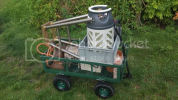- Joined
- Dec 11, 2000
- Messages
- 1,102
I am thinking about using some savings to buy a Paragon HT oven while those savings still have some purchasing power. My workshop is small and it isn't easy to see where an oven could go on the upper level of a bench. There is more scope on the lower shelf of a couple of my benches. I am still young enough that squatting down to access is still possible.
Is this viable?
I was thinking about putting it where the mini-forge is stored (I will most likely get rid of the forge) after clearing some space to the right. Would need a door with side hinges rather than bottom, I think.

Thanks
Chris
Is this viable?
I was thinking about putting it where the mini-forge is stored (I will most likely get rid of the forge) after clearing some space to the right. Would need a door with side hinges rather than bottom, I think.

Thanks
Chris




